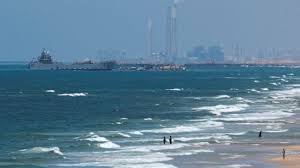Humanitarian aid has finally begun flowing into Gaza via a U.S. military-built pier after several days of logistical delays. This significant development was announced by top U.S. officials on Wednesday, providing a glimmer of hope for the desperate civilians in Gaza.
The Logistics of Humanitarian Aid
Delays and Challenges
Logistical Hurdles
For days, the flow of aid into Gaza was hindered by numerous logistical challenges. Coordinating the delivery of such a massive volume of aid required meticulous planning and execution, compounded by the complexity of the conflict zone.
Addressing the Issues
The U.S. military, along with international partners, worked tirelessly to address these issues. This involved setting up a robust supply chain to ensure that aid could be delivered efficiently and safely to those in need.
The Role of the U.S. Military
Building the Pier
A pivotal part of the solution was the construction of a pier by the U.S. military. This pier, built specifically to facilitate the delivery of humanitarian aid, has proven to be a critical infrastructure development in overcoming the logistical barriers.
Transporting Aid from Cyprus
As of Wednesday morning, the U.S. military had successfully transported over 600 metric tons of aid from Cyprus. This monumental effort underscores the commitment of the U.S. to alleviate the suffering in Gaza.
The Nature of the Aid Delivered
Types of Aid
Food Supplies
A significant portion of the aid consists of food supplies. These are essential to address the acute hunger faced by many in Gaza, providing much-needed nourishment to vulnerable populations.
Medical Supplies
Medical supplies are another critical component of the aid. Hospitals and clinics in Gaza are overwhelmed, and these supplies are vital to treat the injured and sick, helping to save lives and improve health outcomes.
Distribution Process
From Beach to Civilians
The process of moving aid from the beach to the hands of civilians involves a coordinated effort. Trucks and other vehicles are used to transport the supplies inland, ensuring that they reach those most in need as quickly as possible.
Ensuring Fair Distribution
To prevent aid from falling into the wrong hands and to ensure fair distribution, there are strict protocols and monitoring systems in place. This helps to maximize the impact of the humanitarian efforts.
The Human Impact
Stories from the Ground
Desperate Need
The civilians in Gaza have been enduring severe hardships. The arrival of aid brings a ray of hope to families struggling to survive amidst the devastation. Personal stories from the ground highlight the desperate need for continued support.
Immediate Relief
For many, the aid provides immediate relief. Access to food, clean water, and medical care can make a profound difference in their daily lives, offering a sense of stability and security in an otherwise unstable environment.
Psychological Impact
Hope and Resilience
The influx of aid not only addresses physical needs but also boosts the morale of the affected population. It serves as a reminder that the world has not forgotten them, fostering hope and resilience amidst the ongoing crisis.
Long-term Recovery
While immediate relief is crucial, the long-term recovery of Gaza will require sustained support. The current aid efforts are a step in the right direction, but continued international cooperation will be necessary to rebuild and restore the region.
International Reactions
Global Support
International Cooperation
The delivery of aid to Gaza has been a collaborative effort, with multiple countries and organizations playing a role. This international cooperation is vital for addressing such large-scale humanitarian crises.
Diplomatic Efforts
Diplomatic efforts have been instrumental in facilitating the flow of aid. Negotiations and agreements between various stakeholders have helped to open channels and ensure the safe passage of supplies.
Challenges Ahead
Ensuring Continued Access
One of the primary challenges moving forward is ensuring that the flow of aid continues unabated. This requires ongoing diplomatic engagement and logistical planning to keep the supply chains open.
Addressing Root Causes
While delivering aid addresses immediate needs, it is equally important to address the root causes of the conflict. Sustainable peace and stability in the region are essential for the long-term well-being of its people.
Future Prospects
Strengthening Infrastructure
Building Capacity
Strengthening Gaza’s infrastructure is a key priority. This involves building local capacity to handle and distribute aid, as well as improving overall living conditions to reduce dependence on external assistance.
Investment in Development
Investment in development projects can help to create jobs, improve education, and enhance healthcare, contributing to a more resilient and self-sufficient society.
Continued International Engagement
Sustained Support
The international community must remain engaged in supporting Gaza. This includes financial aid, technical assistance, and diplomatic efforts to ensure that progress is maintained.
Promoting Peace
Ultimately, promoting peace and reconciliation is crucial. Efforts to foster dialogue and understanding between conflicting parties can pave the way for a more stable and prosperous future.
The commencement of humanitarian aid delivery to Gaza through a U.S. military-built pier marks a significant step in addressing the urgent needs of its civilians. Despite the logistical challenges, the successful transportation of over 600 metric tons of aid from Cyprus reflects a dedicated effort to provide relief. Continued international cooperation and a focus on long-term solutions are essential to support Gaza’s recovery and ensure a brighter future for its people.




